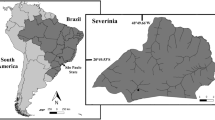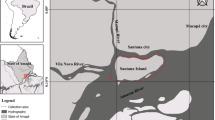Abstract
The study presents new information on the population characteristics of two river snail species, Viviparus viviparus (Linnaeus, 1758) and V. contectus (Millet, 1813), in the water bodies of Ukraine in 2007–2018. The analyzed features include data of the species distribution, numbers and biomass, age and sex ratio population structure, fertility, growth and production. Ecological factors (flow rate, temperature, the concentration of oxygen, pH, organic matter) that limit the distribution of two Viviparidae species in varying biotopes were identified. Recently, the frequency of occurrence, and the number and biomass of populations V. viviparus and V. contectus have been observed to decrease. The probable reason is the declining environmental conditions induced by the climatic changes and anthropogenic pressure. In waters of Ukraine, maximum age is five years for V. viviparus mollusks and six years for V. contectus. High anthropogenic pressure disturbs age structure of viviparid species in water bodies, causing higher ratios of middle-age (two to four year old) snails and decreased or absent young (up to one year old) and oldest (five−six year old) mollusks. The major factor here is high level of saprobity of water bodies, which is accompanied by formation of hypoxic zones and causes significant death rates in the youngest and oldest mollusks. Those are the most vulnerable age classes in mollusk populations.








Similar content being viewed by others
References
Alimov AF (1981) Functional ecology of freshwater bivalve mollusks. Nauka, Leningrad. (in Russian)
Alimov AF, Bogatov VV, Golubkov SM (2013) Production hydrobiology. Nauka, St. Petersburg. (in Russian)
Andriichuk TV (2015) The variability and reproductive organs’ structure of Viviparus viviparus (Linnaeus, 1758) and Viviparus contectus (millet, 1813) (Gastropoda, Viviparidae) within Ukraine: the contrastive analysis. Abstract of thesis for a candidate degree in biology. The I. I, Schmalhausen Institute of Zoology of NAS of Ukraine, Kyiv. (in Ukrainian)
Anistratenko VV, Anistratenko OYu (2001) Class polyplacophora; class gastropoda: cyclobranchia, scutibranchia and pectinibranchia (part). Fauna of Ukraine 29, Mollusks 1 (1), Veles, Kiev. (in Russian)
Anistratenko VV, Degtiarenko EV, Anistratenko OY, Prozorova LA (2014) Modern distribution of gastropod mollusks of the family Viviparidae (Caenogastropoda) in continental water bodies of Eurasia. Zool Zh 93(2):211–220. https://doi.org/10.7868/S0044513413120040. (in Russian)
Begon M, Harper JL, Townsend CR (1989) Ecology: individuals, populations and communities. Mir 1, Moscow. (in Russian)
Bertalanffy LV (1960) Principles and theory of growth. Fundamental aspects of normal and malignant growth / ed. W. W. Nowinski. Elsevier, Amsterdam, pp 137–259
Cichy A, Żbikowska A (2016) Atlas of Digenea developmental stages. Themorphological characteristics and spread within the populations of freshwater snails from the Brodnickie Lakeland. Poland, Wydawnictwo Naukowe UMK, Toruń
Galaktionov КV (1985) The infection of males and females of molluscs of the genus Littorina (Gastropoda, Prosobranchia) with parthenites of trematodes in the Barents Sea coastal waters. Parazitologia 19(3):213–219. (in Russian)
Geodakyan VА (1974) Differential mortality and reaction norms of males and females ontogenetic and phylogenetic plasticity. Zh Obshch Biol 35(3):376–385
Glöer P (2002) Sübwassergastropoden. Mollusca I. Nord-und Mitteleuropas. ConchBooks, Hackenheim
Glöer P, Georgiev D (2014) Redescription of Viviparus sphaeridius Bourguignat 1880 with an identification key of the European Viviparus species (Gastropoda: Viviparidae). Ecol Mont 1(2):96–102
Guseva TV, Molchanova YP, Zaika EA, Vinichenko VN, Averochkin EM (2000) Hydrochemical indicators of the environment state. Ekoline, Moscow. (in Russian)
Jeźewski W (2004) Occurrence of Digenea (Trematoda) in two Viviparus species from lakes, rivers and а dam reservoir. Helminthologia 41(3):147–150
Khmeleva NN, Golubev AP, Lewandowski K (1995) Populations of Viviparus viviparus (Gastropoda, Prosobranchia) dynamics in water basins of Chernobyl APS zone and in Zeglinsky water reservoir (Poland). Gidrobiol Zh 31:511–521. (in Russian)
Mezhzherin SV, Andriychuk TV, Babko RV, Kuzmina TN (2014) Environmental alternativeness related species of freshwater mussels livebearers Viviparus viviparus and V. contectus (Gastropoda, Viviparidae): retrospective and current status. Pryrodnychiy Al’manah Ser Biol 22:48–54. (in Russian)
Munro JL, Pauly DJ (1983) A simple method for comparing the growth of fishes and invertebrates. Fishbite 1:5–6
Pavelchuk E, Snizhko S (2017) Hydrological and hydro-chemical characteristics of the Zhytomyr Polissia rivers amid the ongoing global warming. 'Volyn' Publisher, Zhytomyr. (in Ukrainian)
Piechocki A, Wawrzyniak-Wydrowska B (2016) Guide to the freshwater and marine mollusca of Poland. Bogucki Wydawnictwo Naukowe, Poznań
Posudin, Yu (2014) Causes, consequences and perspectives of increasing average air temperature in the world, Ukraine and Kiev. Energetyka i avtomatyka 3:124–133. (in Ukrainian)
Stadnychenko AP, Kirichuk GE, Melnychenko RK, Yanovich LM (2003) Stan zagrożenia slimakóv i malży w wodach Ukrainy. XIX Krajowe seminarium malakologiczne (22−24 wrzesnia 2003 r.), Slupsk, pp 49–50
Uvaeva EI, Shcherbina GK (2017) The role of Viviparus contectus (Millet) (Mollusca, Viviparidae) in the sedimentation of suspension and transformation of organic matter in the Tnya River (Ukraine). Inland Water Biol 10(4):415–418. https://doi.org/10.1134/S1995082917040113
Uvayeva OI (2018a) Seasonal dynamics of numbers and biomass of river snails (Mollusca, Viviparidae) in water bodies of Polissia. Pryrodnychiy Al’manah Ser Biol 25:82–88
Uvayeva OI (2018b) Long-term dynamics of numbers and biomass in populations of Viviparidae snails in the rivers of Polissia. Nauk Zap Ternop Nac Ped Un Ser Biol 1(72):63–69. (in Ukrainian)
Uvayeva OI (2019) The many-year growth dynamics of the mollusks of Fam. Viviparidae in the water bodies of Ukrainian Polissya. Hydrobiol J 55(6):65–72. https://doi.org/10.1615/HydrobJ.v55.i6.60
Uvayeva YI, Shurova NM (2018) Prodaction of Viviparus viviparus (Mollusca, Gastropoda) in the water bodies of Ukraine Polissya zone. Hydrobiol J 54(5):28–35. https://doi.org/10.1615/HydrobJ.v54.i5.30
Uvayeva OI, Stadnichenko AP (2016) Sedimentation activity of Viviparus viviparus (Mollusca: Gastropoda: Pectinibranchia) in the vidsichne reservoir. Hydrobiol J 52(5):18−24. https://doi.org/10.1615/HydrobJ.v52.i5.20
Welter-Schules FW (2012) European non-marine molluscs, a guide for species identification. Planet Poster Editions, Göttingen
Author information
Authors and Affiliations
Corresponding author
Ethics declarations
Conflict of interest disclosure
On behalf of all authors, the corresponding author states that there is no conflict of interest.
Additional information
Publisher’s note
Springer Nature remains neutral with regard to jurisdictional claims in published maps and institutional affiliations.
Rights and permissions
About this article
Cite this article
Uvayeva, O., Utevsky, S. Comparative analysis of population characteristics of two viviparid species (Mollusca: Viviparidae) in water bodies of Ukraine. Biologia 76, 113–122 (2021). https://doi.org/10.2478/s11756-020-00504-z
Received:
Accepted:
Published:
Issue Date:
DOI: https://doi.org/10.2478/s11756-020-00504-z




